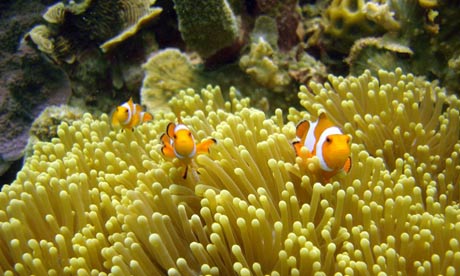The Guardian, UK

Clownfish swimming among the tentacles of sea anemones in Indonesia. Photograph: Science Picture Library
The majority of the world's coral reefs are in danger of being killed off by rising levels of greenhouse gases, scientists warned yesterday. Researchers from Britain, the US and Australia, working with teams from the UN and the World Bank, voiced their concerns after a study revealed 98% of the world's reef habitats are likely to become too acidic for corals to grow by 2050.
The loss of big coral reefs would have a devastating effect on communities, many of which rely on fish and other marine life that shelter in the reefs. It would leave coastlines unprotected against storm surges and damage often-crucial income from tourism. Among the first victims of acidifying oceans will be Australia's Great Barrier Reef, the world's largest organic structure.
The oceans absorb around a third of the 20bn tonnes of carbon dioxide produced each year by human activity. While the process helps to slow global warming by keeping the gas from the atmosphere, in sea water it dissolves to form carbonic acid - rising levels of which cause carbonates to dissolve. One of these minerals, aragonite, is used by corals and other marine organisms to grow their skeletons. It is particularly susceptible to carbonic acid. Without it, corals become brittle and are unable to grow and repair damage caused by fish, snails and natural erosion.
The scientists used computer simulations to model levels of aragonite in the world's oceans from pre-industrial times, when atmospheric carbon dioxide levels stood at 280 parts per million. Present day levels of carbon dioxide are 380ppm, but scientists expect the figure will rise substantially by the end of the century.
The team looked at three scenarios based on predictions of greenhouse gas emissions by the UN's Intergovernmental Panel on Climate Change. The first assumed that atmospheric carbon dioxide was held at today's level, leading to an increase in temperature of 1C by the end of the century. Under this scenario there was enough aragonite left in the oceans for corals to continue growing.
The second scenario looked at the effect of carbon dioxide levels at between 450 and 500ppm, a rise that would increase global temperatures by 2C. Under these conditions only very hardy corals and creatures that lived off them would survive.
In the worst scenario, when carbon dioxide levels rose above 500ppm, the models predicted a 3C rise and a substantial increase in ocean acidity, causing the majority of reefs to die off. The study appears in the journal Science.
"Before the industrial revolution over 98% of warm water coral reefs were bathed with open ocean waters 3.5 times supersaturated with aragonite, meaning that corals could easily extract it to build reefs," said Long Cao, a co-author from the Carnegie Institution in Stanford. "If atmospheric carbon dioxide stabilises at 550ppm, and even that would take concerted international effort, no existing coral reef will remain in such an environment."
Peter Mumby, a reef ecologist at Exeter University, who worked on the study, said: " Reefs help protect coastlines from storm damage by acting as a buffer, so without them storm surges will go straight over and hit the coast."
Under threat
Philippines One of the most threatened coral hot spots, the reefs face damage from pollution, run-off from logging, and dynamite fishing
Gulf of Guinea Around 20 sq km of reef between four islands off the west African coast under threat from coastal development and coral harvesting
Sunda Islands Part of the coral triangle, one of the most diverse coastal areas. Already at threat from destructive fishing and reef fish trade
Southern Mascarene Islands Reefs surrounding Mauritius, Reunion and Rodriguez islands in southern Indian Ocean are under threat from pollution from the sugar cane industry and agricultural development
Eastern South Africa Next to Cape Floristic, this smaller reef is also at risk from over-fishing and tourism

No comments:
Post a Comment